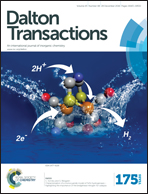Transition metal complex directed lead bromides with tunable structures and visible light driven photocatalytic properties†
Abstract
With similar transition metal (TM) complex cations as structural directing agents (SDAs), six new hybrid lead bromides were synthesized and structurally characterized as [Co(2,2-bipy)3]2{[Co(2,2-bipy)]3Pb7Br24} (1), [Co(2,2-bipy)2Br]PbBr3 (2), [TM(phen)3]Pb2Br6 (TM = Co (3) and Ni (4)), [Co(2,2-bipy)3]Pb3Br9 (5) and [Co(2,2-bipy)3]Pb5Br13·CH3CN (6) with distinct structural types from zero-dimensional (0D) unit, one-dimensional (1D) chain to two-dimensional (2D) layer. Compound 1 contains the 0D {[Co(bipy)]3Pb7Br24}4− units built from the [Pb7Br24] ring attached by three unsaturated [Co(2,2-bipy)]2+ complexes via Co–Br bonds. Under the direction actions of different SDAs, compounds 2 and 3–4 contain two different types of [Pb2Br6]4− chains based on the same octahedral [PbBr6] units but with distinct connecting manners, respectively. Using the same [Co(2,2-bipy)3]3+ as SDA, compound 5 reveals a 1D [Pb3Br9]3− double chain, whereas compound 6 features a 2D complex [Pb5Br13]3− layer. The UV/vis diffuse-reflectance measurements reveal that the title compounds feature tunable band gaps of 1.70–2.29 eV. Under the visible light irradiation, sample 6 exhibits efficient and stable photocatalytic degradation activities over organic pollutants, which mainly originates from the multi-electronic effects of the TM complex cations. A possible photocatalytic mechanism is also proposed based on the radical trapping experiments and electronic band structural calculations.


 Please wait while we load your content...
Please wait while we load your content...